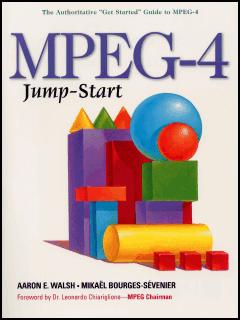Save for the yeoman’s work that our little community does on the MultimediaWiki, it’s generally quite difficult to come by solid technical data on specific multimedia codecs. That even holds true for the “open” MPEG codecs which are wrapped up in NDAs and licensing fees. So I was stunned to find a thick, colorful, well-illustrated book called “MPEG-4 Jump Start” at the local public library.

I thought this looked highly promising because, while I know a lot of the general concepts surrounding image compression, I have never gotten too deep into MPEG-4 video compression for the simple reason that everyone else works on it. Thus, I don’t feel a need to.
Unfortunately, this book is not quite what I expected. I once asked the guru in passing whether or not FFmpeg supported the entire MPEG-4 spec. His terse response: “Very funny.” It turns out that MPEG-4 encompasses a huge number of features relating to sprite movement and 3D stuff that no one ever uses in practice these days. And that, my friends, is what this book was largely focused on. It may help to explain why Amazon presently lists used copies of this giant tome starting at $2.81.
There is, however, a followup volume entitled “More MPEG-4 Jump Start” (why do I get the feeling that MPEG probably has a separate committee dedicated to developing the names of these books?) that claims it will divulge more information about audio and video coding in the MPEG-4 scheme.
You can read an amusing passage about the unused body of MPEG-4 features under the “Enter the MPEG-4 behemoth” section at Deconstructing H.264/AVC.
IIRC, vcodex.com author offered a book with technical details about H.264 with some excerpts available online.
And MPEG-4 is indeed a huge beast. Look in GPAC and MPEG4IP code (all on sf.net) to see more of MPEG-4 standard implementation.
Once I looked into MPEG-4 audio standard and there were about a dozen different audio coding methods there. Video includes also a lot of method – from H.263 variant known as MPEG-4 to H.264 to wavelet coding. Oh, and don’t forget its synthesised objects (look here for basic example) and BIFS, its own language (implemented in GPAC).
Something I notice is that a number of devices from (like the Apple TV and the new update to the XBOX 360) are supporting “MPEG4” whilst not supporting the most commonly seen variants of MPEG4 (i.e. the bits of that huge mess of standards known as MPEG4 used by 3ivx, divx, xvid etc). I don’t know for sure but it wouldn’t surprise me if Microsoft and Apple (both of who are friendly with the media corps) are supporting MPEG4 whilst avoiding specific bits of the standard commonly used for “pirate” video (i.e. pirated TV shows and movies)
I don’t know enough about MPEG4 to say for sure though.
Jonathan: Are you sure it’s not just a matter of changing FourCCs in the AVI file? It’s not uncommon for the corporate players like QuickTime and WMP to not recognize video FourCCs like XviD, DX50, or FMP4.
Nope, reports online suggest that 360 definatly doesn’t support MPEG4 ASP (only Simple and Main). As for the Apple TV, it looks like its simply the case that Apple doesn’t support DivX/XviD/etc in Quicktime.